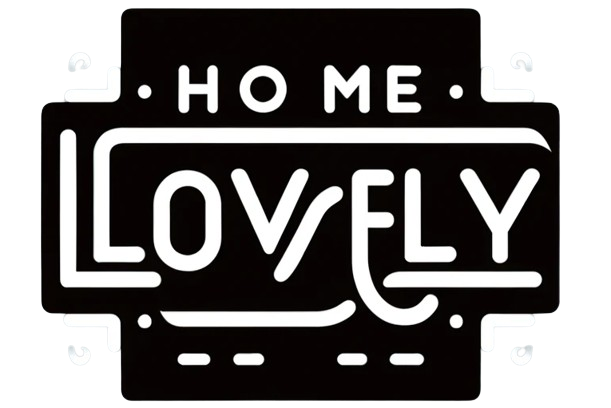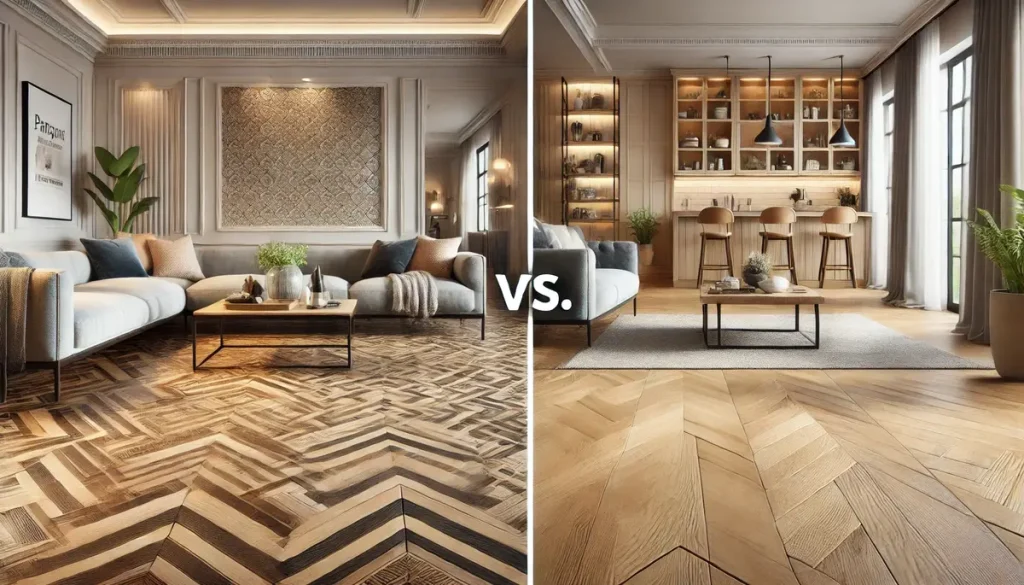Have you ever wondered which flooring option is best suited for your home or office—parquet flooring or hardwood? Flooring plays a critical role in defining the ambiance and functionality of a space, making it essential to make an informed decision. According to recent statistics, wood-based flooring accounts for a significant share of the global flooring market, with millions opting for these versatile options each year. Choosing between parquet flooring and traditional hardwood often comes down to personal preference, durability requirements, and design aspirations.
This blog will explore the differences between parquet flooring and hardwood, helping you understand their unique features, benefits, and suitability for various spaces.
Read More: 3 Kitchen Flooring Ideas for a Stylish Space
What is Parquet Flooring?
Parquet flooring is a type of wood flooring made by arranging small pieces of wood into intricate geometric patterns. These designs, such as herringbone, chevron, and basket weave, make parquet a standout choice for those who prioritize aesthetics.
- Artistic Appeal: Parquet flooring brings a touch of luxury and creativity to interiors, enhancing the visual appeal of spaces. Its patterns are ideal for formal settings like living rooms or grand entryways.
- Material Options: Commonly crafted from oak, walnut, and mahogany, parquet flooring offers a wide range of options to match different design themes.
- Versatility: It is highly versatile and can be used in both residential and commercial spaces where a unique visual statement is desired.
What is Hardwood Flooring?
Hardwood flooring refers to solid planks of wood, commonly derived from trees like oak, maple, or cherry. Known for its timeless appeal, hardwood flooring suits a variety of interior styles, from traditional to contemporary.
- Natural Beauty: Hardwood flooring is prized for its organic and classic appearance, showcasing the natural grain of the wood.
- Durability: Solid hardwood can last decades with proper care, making it a practical choice for high-traffic areas like hallways and kitchens.
- Ease of Refinishing: Hardwood floors can be sanded and refinished multiple times, extending their lifespan and allowing for design updates.
Key Differences Between Parquet Flooring and Hardwood
When deciding between parquet flooring and hardwood, understanding their unique characteristics is essential. Although both options are wood-based and serve as durable flooring solutions, their differences in aesthetics, installation, cost, and maintenance can significantly influence your decision.
Design and Patterns
The most apparent difference lies in their visual appeal.
- Parquet Flooring: Known for its artistic and geometric designs, parquet flooring creates a distinctive visual statement. Patterns like herringbone, chevron, and basket weave are particularly popular, adding sophistication and elegance to spaces. This makes parquet an excellent choice for formal areas or rooms where design is a focal point.
- Hardwood Flooring: Hardwood offers a classic, natural look with its straight planks that showcase the wood grain. It is ideal for creating a warm and traditional ambiance. While simpler than parquet, hardwood’s natural beauty can complement both rustic and modern interiors.
Installation Complexity
The installation process differs significantly between parquet and hardwood flooring due to their construction and design.
- Parquet Flooring: Installing parquet flooring is a meticulous process requiring precision and expertise. The intricate patterns must align perfectly, making professional installation essential. This complexity also increases the installation time compared to hardwood.
- Hardwood Flooring: Hardwood planks are easier and faster to install, often using methods like nailing, gluing, or floating. This straightforward process makes hardwood installation less costly and more accessible for DIY enthusiasts.
Cost Considerations
Cost is another crucial factor when choosing between the two flooring types.
- Parquet Flooring: Due to its intricate patterns and labor-intensive installation, parquet flooring is generally more expensive than hardwood. The use of high-quality materials like exotic woods can further increase the price.
- Hardwood Flooring: The cost of hardwood flooring varies depending on the wood type. Domestic options like oak or maple are relatively affordable, while exotic woods like Brazilian cherry or teak can be more costly. However, its straightforward installation often helps reduce overall expenses.
Maintenance Requirements
Both flooring types require maintenance to preserve their beauty and durability, but their needs differ.
- Parquet Flooring: Parquet is more sensitive to moisture and requires regular care to maintain its appearance. Over time, its patterns can loosen if not properly maintained. Routine polishing and avoiding excessive humidity are crucial for longevity.
- Hardwood Flooring: Hardwood is more forgiving when it comes to maintenance. While it may require refinishing every few years, its overall upkeep is less demanding. However, hardwood is prone to scratches and dents, especially in high-traffic areas.
Durability and Longevity
Durability is a key consideration for any flooring investment.
- Parquet Flooring: While aesthetically appealing, parquet is slightly less durable than hardwood. Its intricate construction makes it vulnerable to moisture and damage in high-traffic areas.
- Hardwood Flooring: Solid hardwood is one of the most durable flooring options, capable of withstanding decades of wear with proper care. It can be sanded and refinished multiple times, extending its lifespan significantly.
Pros and Cons of Parquet Flooring
Parquet flooring brings a unique set of advantages and challenges, making it ideal for some but not all scenarios.
- Advantages:
- Elegant Designs: The detailed patterns of parquet add a luxurious touch to any space.
- Timeless Appeal: Despite being trendy, parquet flooring never goes out of style and suits modern and vintage decor alike.
- Customizable Materials: It offers the flexibility to use various types of wood, enhancing customization options.
- Challenges:
- High Maintenance: Regular polishing is required to maintain its appearance.
- Prone to Damage: Parquet may warp in humid conditions, making it less suitable for bathrooms or basements.
Pros and Cons of Hardwood Flooring
Hardwood flooring is another excellent choice, offering unmatched durability and a classic look. However, it is not without its downsides.
- Advantages:
- Durability: Solid hardwood can withstand decades of wear and tear.
- Refinishing Options: The ability to refinish hardwood extends its usability, ensuring long-term value.
- Wide Variety: A broad range of wood types and finishes makes it adaptable to various design needs.
- Challenges:
- Cost Variability: Exotic hardwood species can be costly.
- Susceptible to Scratches: Hardwood requires care to prevent damage from heavy furniture or sharp objects.
When to Choose Parquet Flooring or Hardwood
Deciding between parquet flooring and hardwood depends on various factors, including your lifestyle, design preferences, functional needs, and budget. Each option offers unique advantages, making them suitable for different spaces and requirements.
When to Choose Parquet Flooring
Parquet flooring is an excellent choice for those who prioritize aesthetics and want to make a bold design statement. Its intricate patterns and luxurious appeal make it ideal for specific settings.
- Formal Settings: Parquet flooring shines in formal spaces like dining rooms, libraries, or offices. Its elegant geometric designs, such as herringbone or chevron, add a sophisticated ambiance that enhances the overall decor.
- Luxury Interiors: If you’re designing a high-end interior, parquet flooring complements luxury furniture and decor seamlessly. It is a popular choice for upscale apartments, luxury homes, and boutique establishments.
- Accent Areas: Parquet works well as an accent feature in spaces like foyers or entryways, where its patterns can serve as a focal point. It’s also a great way to define a particular area within a room without additional partitions.
- Design Flexibility: With its variety of wood types and patterns, parquet flooring allows customization to suit specific design themes, from vintage to modern aesthetics.
When to Choose Hardwood Flooring
Hardwood flooring is the go-to option for those seeking durability and timeless appeal. It is well-suited for spaces where functionality and resilience are as important as aesthetics.
- Family Homes: Hardwood flooring is ideal for family homes where spaces endure high foot traffic. Its durability ensures it can handle daily wear and tear without compromising its appearance.
- Living Rooms and Bedrooms: The warm and inviting look of hardwood makes it perfect for communal and private spaces like living rooms and bedrooms. Its simple, natural grain blends effortlessly with most interior design styles.
- High-Traffic Areas: Hardwood’s strength and ability to be refinished multiple times make it suitable for hallways, kitchens, and other areas that see frequent use. Its straightforward maintenance also makes it easier to keep clean in busy households.
- Long-Term Investment: Hardwood flooring is a solid choice for homeowners looking for a long-term solution. Its longevity and ability to be refinished mean it remains beautiful and functional for decades.
Factors to Consider Before Making a Choice
While the decision largely depends on the space and its intended use, there are a few universal considerations to keep in mind:
- Budget: Parquet flooring tends to be more expensive than hardwood due to its design complexity and installation process. Evaluate your budget before making a decision.
- Maintenance: If you prefer a low-maintenance option, hardwood flooring might be more suitable. Parquet requires regular upkeep to maintain its intricate designs.
- Interior Design Goals: Choose parquet for spaces where aesthetics and unique designs are a priority. Opt for hardwood if you’re aiming for a classic and versatile look that complements various decor styles.
Consulting a Professional
Choosing between parquet flooring and hardwood can be challenging, especially with so many variables to consider. Consulting a flooring expert can help you:
- Assess the suitability of each option based on your space, climate, and budget.
- Understand the installation and maintenance requirements for both types of flooring.
- Make an informed decision that aligns with your lifestyle and aesthetic goals.
By considering the unique characteristics of parquet flooring and hardwood, as well as the specific needs of your space, you can confidently select the best flooring solution for your home or office.
Conclusion
Choosing between parquet flooring and hardwood ultimately comes down to your design goals and practical needs. While parquet flooring excels in creating a visually stunning space, hardwood offers durability and timeless appeal. Understanding their differences in terms of design, cost, and maintenance will help you make the best decision for your space.

